Abstract
In this work, the electrical conductivity of CuO/glycerol nanofluid was measured at a temperature range of 20–60 °C, volume fraction of 0.1–1.5% and nanoparticle size of 20–60 nm. The experimental data were predicted by the perceptron neural network. The results showed that the electrical conductivity increases with temperature, especially in higher volume fractions. These results are attributed to the accumulation of nanoparticles in the presence of the field and their Brownian motion at different temperatures and the reduction of electrical conductivity at higher nanoparticle sizes is attributed to the decreased mobility of nanoparticles as load carriers as well as to their decrease in volume unit per constant volume fraction. The results revealed that sonication time up to 70 min increases the nanofluid stability, while further increase in the sonication time decreases the nanofluid stability. In the modeling, input data to perceptron artificial neural network are nanofluid temperature, nanoparticle size, sonication time and volume fraction and electrical conductivity is considered as output. The results obtained from self-organizing map (SOM) showed that the winner neuron which has the most data is neuron 31. The values of the correlation coefficient (R2), the mean of squared errors (MSE) and maximum error(emax) used to evaluate the perceptron artificial neural network with 2 hidden layers and 31 neurons are 1, 2.3542 × 10−17 and 0 respectively, indicating the high accuracy of the network.
1. Introduction
During past decades, a subject which was comprehensively investigated can be enumerated as heat transfer in industrial apparatus. This activity is so crucial since the generated heat can impede the operation of the device as the impacts of the heat on the equipment. Additionally, it can be caused severe damage to the device. The utilization of fluids with the characteristic of high heat transfer rate can be mentioned as a method for augmenting heat transfer in cooling systems. Thus, specialists have focused on the capacity identified in nanofluids. Nanoparticles in the scale of 1–100 nm are utilized in nanofluids [1]. Various investigations have been presented for the sake of identifying the dynamics of nanofluids heat transfer [2,3,4,5,6,7,8,9,10] and thermal properties like specific heat capacity [11], thermal diffusivity [12], density [13]. Adio et al. [14] studied factors affecting the electrical conductivity of magnesium oxide–ethylene glycol (MgO–EG) nanofluid. The effects of temperature and volume fraction were investigated. The experimental results showed that electrical conductivity increased with temperature. Moreover, the increase in the MgO volume fraction increased electrical conductivity values of the MgO–EG nanofluid.
In a study, the electrical conductivity of thulium oxides–ethylene glycol nanofluids based on nanoparticles with different sizes has been investigated. Measurements were conducted at constant temperature of 293.15 (K) for various mass concentrations from 0% to 20% with 5% interval. Their results indicate that increase in mass concentration of nanoparticles in base fluid causes increase in electrical conductivity of Tm2O3–EG nanofluids. The enhancement in the electrical conductivity of nanosuspensions of thulium oxide is dependent on particle size [15].
Zakaria et al. [16] investigated electrical conductivity of Al2O3 nanofluid in water—ethylene glycol mixture experimentally. The obtained results revealed that electrical conductivities measured in 0.1, 0.3 and 0.5% volume concentration of Al2O3 in base fluid decreased as the EG concentration increased even though the base fluids’ electrical conductivity behave differently. Additionally, the calculation of the electrical conductivity associated with iron oxide nanofluids has been provided in another examination. This study presented the electrical conductivity contributed to iron oxide nanoparticles at various particle volume fractions and temperatures. A 4-cell conductivity electrode meter measures the electrical conductivity. By increasing temperature and the particle volume fraction, the electrical conductivity of iron oxide nanofluids linearly rises. Owing to temperature and the particle volume fraction of 22.55% and 160.49%, respectively, the highest improvement of electrical conductivity of iron oxide nanofluids is obtained [17]. In other evaluations by Abdolbaqi et al. [18], the thermal conductivity and electrical conductivity of bioglycol-water mixed nanofluids containing Al2O3 nanoparticles were investigated. According to their result, bioglycol-water mixtures have displayed improvement in thermal performance of 7.5% in comparison with propylene glycol in similar circumstances. The thermal conductivity of nanofluid increased as a function of volume concentration and temperature. Electrical conductivity was observed to decrease as the volume concentration increased. The influence of nanoparticle concentration and temperature on viscosity and thermal conductivity of a nanofluid has been experimentally studied by Águila et al. [19]. According to the obtained results of the NanoPCM, thermal conductivity is approximately consistent in the examined temperature range, the viscosity reduces non-linearly with temperature. Regarding the influence of nanoparticle concentration, both viscosity and thermal conductivity augmented with nanoparticle concentration. Regarding the base fluid, thermal conductivity increased up to 9%. Also, viscosity enhanced up to 60% in both cases with increasing concentration.
Aghayari et al. [20] used artificial neural networks, including two-layer perceptron feed forward and a back propagation Levenberg-Marquardt training algorithm to evaluate and predict the thermal conductivity of iron oxide nanofluid at different temperatures and volume fractions by using experimental data. They found that artificial neural networks model has a reasonable agreement in predicting experimental data. So it can be concluded that the ANN model is an effective method for prediction of the thermal conductivity of nanofluids and has better prediction accuracy and simplicity compared with the other existing theoretical methods. The conclusion of the thermal conductivity associated with Water-Ethylene glycol and Silica as the base nanofluid has been presented by Ahmadi Esfahani et al. [21] with the temperature range of 25–50 °C for samples with volume fractions of 0.1%, 0.5%, 1%, 1.5%, 2%, 3% and 5%. As indicated in the results, by augmenting volume fraction and temperature, thermal conductivity enhanced significantly. The highest thermal conductivity (45.5%) happened at the temperature of 50 °C and volume fraction of 5%. Based on the assessment, the maximum quantity contributed to the margin of deviation for the presented equation has been found to be 2.2%, which is favorable in an experimental equation.
Akbari et al. [22] used SiO2/EG nanofluids for measuring viscosity in different temperatures ranging from 30 °C to 50 °C and volume fraction range of 0.1–3.0%. The measurements showed that the viscosity rises with growing the nanoparticles concentration and diminishes with rising temperature. The values of viscosity ratio indicated that with increasing the solid volume fraction from 0.1 to 3%, the viscosity increases up to 116%. Other researcher presented the effects of temperature (20 °C < T < 50 °C) and volume fraction (0 < φ < 4%) on the thermal conductivity of zinc oxide/ethylene glycol-water nanofluid. Results showed that the thermal conductivity increases uniformly with increasing solid volume fraction and temperature. The results also revealed that the thermal conductivity of nanofluids significantly increases with increasing solid volume fraction at higher temperatures. Experimental thermal conductivity enhancement of the nanofluid in comparison with the Maxwell model indicated that Maxwell model was unable to predict the thermal conductivity of the present nanofluid [23]. Hemmat Esfe et al. [24] used experimental data to predict viscosity and thermal conductivity of nanofluid aluminum oxide in a mixture of water and ethylene glycol by Artificial Neural Network. The inputs of ANN were temperature and volume fraction and outputs were viscosity and thermal conductivity. Finally, Pareto Front and the corresponding optimum points were provided and introduced. Optimal results showed that the optimum viscosity and thermal conductivity occurs at maximum temperature. In 2017, Abdollahi Moghaddam et al. [25] evaluated rheological variations of MWCNT-CuO (30–70)/SAE40 nanohybrid with temperature and solid volume fraction. The viscosity at volume fractions 0.0625–1% was measured in temperatures 25–50 °C and different shear rates. The results showed that in a concentration of 1 vol %, the viscosity of hybrid nanolubricant was 29.47% more than the viscosity of the base oil. They also used, an Artificial Neural Network including multilayer perceptron method with two hidden layers, one of which had five neurons and the other one had four neurons. The modeling results were R-squared (0.9966), MSE (0.00002081) and AARD (0.0055). Hemmat Esfe et al. [26] applied artificial neural network in order to model the viscosity of the aqueous nanofluid of TiO2 using experimental data. The inputs for the applied model were temperature and nanoparticles mass fraction. A network with one hidden layer and 4 neurons was used. The regression coefficient was obtained 0.9998 in this modeling, showing very high precision of neural network with a very simple structure. In another study, the thermal conductivity of copper oxide nanofluid was predicted using feed forward back propagation artificial neural network (FFBP-ANN). In addition, in order to evaluate accuracy prediction, indices of root-mean-square error, coefficient of determination (R2) and mean absolute percentage error were used. FFBP-ANN with two input parameters (volume fraction and nanofluid temperature) and one output parameter (nanofluid thermal conductivity) in addition to two hidden layers and one outer layer for which purelin, logsig and tansig functions used was considered as the most optimum structure for modeling with neuron number of 4-10-1. The modeling results were fitted with experimental data well [27].
In this work, the electrical conductivity of CuO/glycerol nanofluid was measured experimentally and then, the measured data were predicted using the multilayer perceptron neural network with the certain number of neurons obtained from self-organizing map neural network. Among the goals and novelties of this paper is using a self-organizing map (SOM) artificial neural network for finding the winner neuron. In the present study, the winner neuron with most experimental data is identified and then used in the perceptron artificial neural network for prediction of the electrical conductivity of the CuO/glycerol nanofluid and contrary to the previous studies done for finding the winner neuron, there is no need for trial and error method.
2. Materials and Methods
2.1. Preparation and Characterization of CuO/Glycerol Nanofluid
In this work, copper oxide nanoparticles and glycerol as base fluid were purchased from Sigma Aldrich. The scanning electron microscopy (SEM) image of the nanoparticles supplied by the manufacturer is clearly shown in Figure 1. As shown in Figure 1, nanoparticles have a size about 20–60 nm and are almost spherical.

Figure 1.
Scanning electron microscope (SEM) image of a copper oxide nanoparticle.
2.2. Preparation of CuO/Glycerol Nanofluid
A two-step method was used to prepare a stable CuO/glycerol nanofluid. Initially, when powder of CuO nanoparticles was added to the base fluid, a non-homogeneous and unstable state was formed. To this end, a certain number of nanoparticles and acetyltri methyl ammonium with the optimal ratio of about 1 to 20 were mixed using a Hanna instruments magnetic stirrer at a rate of 500 rpm for 5 h. Subsequently, for complete stability of the nanofluid for a few weeks, an ultrasonic bar sonicator (-UP GmbH Hielscher 400S, Hielscher Co., Teltow, Berlin, Germany) was used with a frequency of 24 kHz, wave amplitude of 100 and an output power of 400 Watts. Since the ultrasonic waves break down the particle accumulation into smaller pieces and make the distribution of the nanoparticles uniform, the effect of the ultrasonic sonication time on the nanofluid stability was measured. The sedimentation of nanoparticles at the bottom of the test vessel was considered as a significant criterion for stability and was measured with a high-precision millimeter ruler. In the present study, we used very low volume fraction of 0.1%, 0.4%, 0.8%, 1% and 1.5% to fully guarantee the nanofluid stability. Sodium dodecyl sulfate and polyvinylpyrrolidone were used respectively as anionic and nonionic surfactants because these materials, respectively by increasing the electrostatic repulsion force and the spatial repulsion force between the particles, improve the dispersion of the nanoparticles in the base fluid.
2.3. Electrical Conductivity Measuring Device
The electrical conductivity of CuO/glycerol nanofluid was measured by a Model AZ8351 with accuracy of ±1% at various temperatures ranging from 20 to 60 °C and different volume concentrations of 0.1%, 0.4%, 0.8%, 1% and 1.5%. Before conducting electrical conductivity experiments, cond.meter was calibrated at 25 °C using reference solutions of KCL 1413 and 80 μS/cm and the calibration results are shown in Table 1. Model AZ8351 cond.meter has a small and compact size measuring range of 0–1999 μS and with a waterproof body can be easily used. It can display both the temperature and conductivity simultaneously.

Table 1.
Values obtained from calibration of cond.meter with reference solutions.
2.4. Artificial Neural Network
Artificial neural network (ANN) is one of the computational methods, which attempts to offer a mapping between the input space (input layer) and the desirable space (output layer) by understanding the intrinsic relationships between the data using learning process and the processors called the neurons. The hidden layer(s) processes the received information from the input layer and provides the output layer with this processed information. Each network is trained by receiving examples. Training is a process that ultimately leads to learning. Network learning is performed when the communication weights between the layers change so that the difference between predicted and calculated values is acceptable [28]. Having achieved these conditions, the learning process has been realized. These weights represent the memory and network knowledge. Trained neural network can be used to predict outputs appropriate to the new set of data [28]. Due to the structure of the artificial neural network, its main features are high processing speed, ability to learn pattern, ability to generalize knowledge after learning, flexibility to deal with unwanted errors and not causing significant disturbance in the event of problems in part of the connections due to the distribution of network weights [28].
2.5. Artificial Neural Network Design
Considering three factors of nanofluid temperature, different sizes of nanoparticles and volume concentration of nanofluid, changes in the electrical conductivity of CuO/glycerol nanofluid under different conditions are obtained. The proposed neural network topology and the input and output parameters for the network are shown with the different number of layers. An artificial neural network with 1 and 2 layers has been used, containing neurons in each layer. In this work, the data of nanofluid temperature, nanoparticle size and volume concentration of nanofluid are considered as input to the network as well as the electrical conductivity data obtained from experimental results are considered as output. The MLP neural network was used to predict the electrical conductivity of CuO/glycerol nanofluid in the sigmoid tangent function. One of the problems may arise when training a neural network is the overtraining of network so that during the network training, the error reaches an acceptable amount but when evaluated, the network error is far more than the training data error [28,29]. There are two ways to avoid overtraining: (a) stopping the training quickly and (b) selecting the lowest number of neurons in hidden layer [28]. To train the network, data were first randomly divided into three parts, so that 70% of the data for training, 15% of the data for evaluating and 15% of the data for testing the network were used. During the training, the training process is interrupted when the error between the training and evaluation data increases. The values of the correlation coefficient (R2) and mean square error (MSE) were used to evaluate the obtained results [29]. MSE and R2 were used to evaluate the obtained results [29]:
where N is the number of experimental data, is the experimental data dedicated to electrical conductivity and is predicted by neural network. Moreover, is the mean value of electrical conductivity and is the mean value of error.
The Levenberg-Marquardt (LM) training algorithm was used to update the artificial neural network weights, which is one of the most widely used algorithms because it performs network training very quickly and minimizes the level of error available [30,31]. In fact, this algorithm is designed to increase the speed of network learning based on the Hysen matrix. For mathematical explanation of the solution, it can be concluded that the output of the input layer neurons is considered as the input for the hidden layer. Similarly, the output of hidden layer neurons is considered as input of the output layer. Each neuron in the input layer based on the following equation performs the process on the input parameters of the neural network:
In Equation (3), is the output neuron, is neuron activation function and is the number of network input parameters. represents the th input parameter. is the weight of each neuron and is the bias of the input parameters. In the present study, the hyperbolic tangent activation function is used in the middle layers and the linear function in the output layer. Table 2 shows the minimum, average and maximum values for the input data.

Table 2.
The minimum, average and maximum values for the input data.
3. Results and Discussion
Figure 2 shows the effect of sonication time on the height of the sediment layer of CuO/glycerol nanoparticles in different volume fraction. The results of the evaluation showed that by increasing sonication time up to 70 min, the height of the sediment layer decreases, while further increase in the sonication time leads to an increase in the height of the sediment layer. These results can be explained by the fact that when the CuO/glycerol nanofluid is exposed to ultrasound sonication, all of the fluid’s points are exposed to extreme oscillations and acceleration. In such a high acceleration, at these points, a cavitation bubble is created, growing over a period of time and reaching a critical diameter and eventually collapsing. During this process, there is a special local condition called hot spot, resulting in a high temperature and a high-pressure and rapid micro-flow of the liquid. The movement of this flow among the nanoparticles exert a very strong shear force on the electrostatic forces between particles (gravity and Van der Waals forces). In this way, the particles are separated from each other and the nanofluid stability increases. When the nanofluid is exposed to ultrasound sonication for more than 70 min, the suspension temperature increases and the smaller particles are accelerated and collided with ultrasonic wave vibrations at the same rate as micro-flow passing through particles. Therefore, a mass of particles has been formed, causing nanofluid instability. By increasing sonication time, a larger mass of particles is formed and the nanofluid stability decreases. An excessive increase in sonication time may increase the temperature of the nanofluid so that eventually it evaporates.
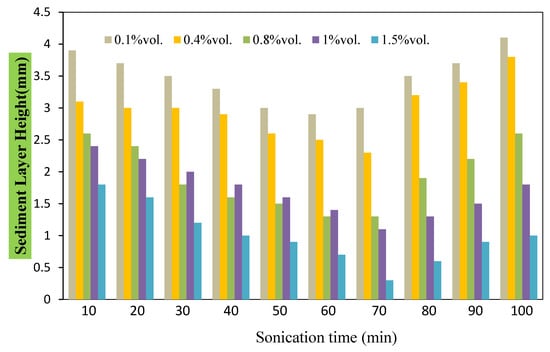
Figure 2.
Effect of sonication time on the stability of CuO/glycerol nanofluid.
Usually, there is a direct relationship between higher inputs and higher excitability. The higher the number of inputs, the more excitable the neurons are and the smaller the number of data, the less excitable the neurons are. According to Figure 3, neuron 31 is the most successful ones and the most data assigned to themselves are 21 data. These neurons have covered more points than other neurons. The neurons without data are indicative of their failure to absorb data. According to the results of the artificial neural network SOM, the winner neuron is neuron 31 that can be used in the MLP neural network.
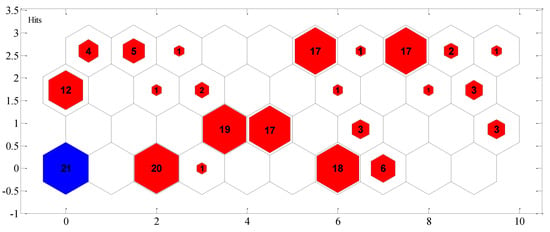
Figure 3.
Statistics chart of winning neurons of self-organizing map (SOM) neural network.
The scattered values of the electrical conductivity of CuO/glycerol nanofluid predicted by the neural network versus the experimental values obtained with 2 hidden layers are shown in Figure 4. Less scattered predicted data around the regression line are indicative of the high accuracy of the model in the data estimation. This figure largely represents the efficacy of the selected neural network model. The purpose of the comparison of predicted values (y) and experimental data (x) is to determine the accuracy of the network introduced during the network testing process. The regression line is depicted in order to show the overlapping of the values obtained in this figure. As can be seen, the values of the correlation coefficient (R2) and mean square error (MSE) for the data of the electrical conductivity coefficient of the CuO/glycerol nanofluid with 2 hidden layers are 1 and 2.3542 × 10−17, respectively, indicating the high accuracy of the network.
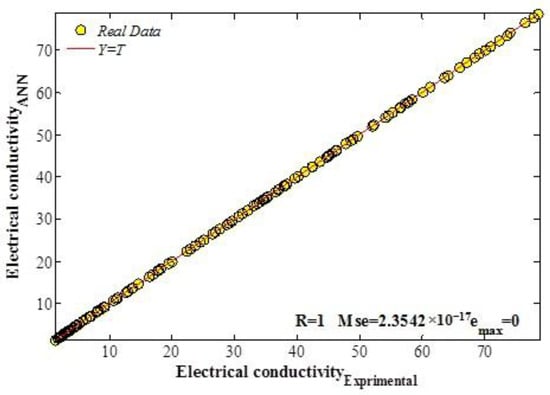
Figure 4.
Comparison of the electrical conductivity predicted by the neural network and experimental results for all data in a network with 2 hidden layers and 31 neurons.
The maximum error (emax) obtained by the two-layer configuration is zero, which is very favorable and represents a successful prediction. Also, the accuracy of the results of the prediction of the electrical conductivity of the nanofluid for the training, validation and testing data and all data is shown in Figure 5. As can be seen, the values of the correlation coefficient and the sum of the squared errors are very normal and represent a successful prediction and evaluation. The computational time for 1 and 2-layer configurations is 4 and 7 seconds, respectively, which does not differ greatly and shows the stability of both configurations clearly.
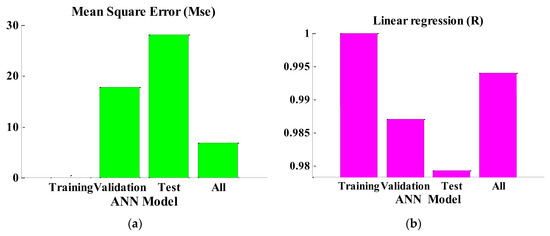
Figure 5.
The obtained values of the correlation coefficient and the sum of the squared errors in a network with 2 hidden layers and 31 neurons. (a) mean square error; (b) linear regression.
To evaluate ANN model and compare it with other sources of information, data from nearly 12 references were used to collect 520 data. Table 3 represents the general characteristics of the nanofluids used and their measurement range. In this database including 520 data and under the different temperature, nanoparticle size and volume fraction conditions, 70, 15 and 15 percent of the data were evaluated as training, validation and testing data, respectively.

Table 3.
Details of data bank used for developing the artificial neural network (ANN) model.
As shown clearly in Figure 6, Figure 7, Figure 8 and Figure 9, the values obtained for the correlation coefficient, sum of the squared errors and the maximum error for 70% of the data, which contains 364 data, are very normal for the network training and are 0.99999, 0.02103 and 0.5427. These values for validation and testing data, which collectively contain 156 data, are 0.9997, 0.38509, 3.3646 and 0.99972, 0.29029 and 3.3646. Therefore, it can be said that the network with two layers and 31 neurons is properly trained and no phenomena such as overfitting have occurred and the network has successfully predicted the electrical conductivity of the nanofluids and the network output is very normal. If the correlation coefficient is close to 1, then the predicted values are identical with the values measured in the laboratory. One of the problems that occurs for neural networks with low data in their training is the overfitting phenomenon causing the model to become non-general. One of the methods for detecting the overfitting problem is to check the error rate for testing and validation data. The proximity of correlation coefficient values for this type of data indicates that the overfitting phenomenon has not occurred in the model.
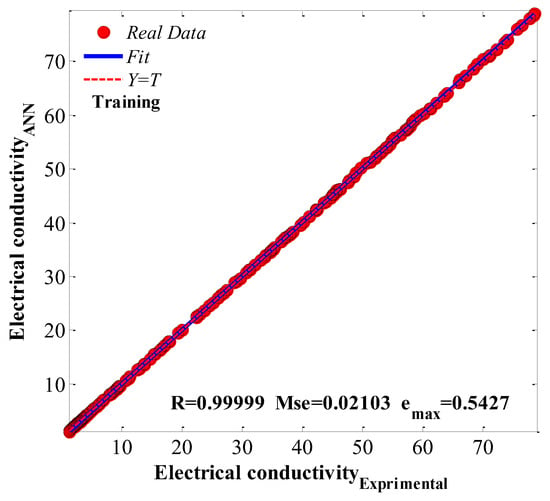
Figure 6.
Comparison of predicted values of electrical conductivity of nanofluids by neural networks and experimental results for training data.
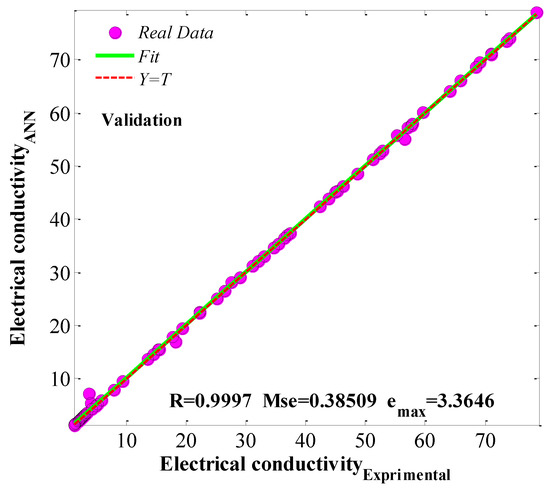
Figure 7.
Comparison of predicted values of electrical conductivity of nanofluids by neural networks and experimental results for validation data.
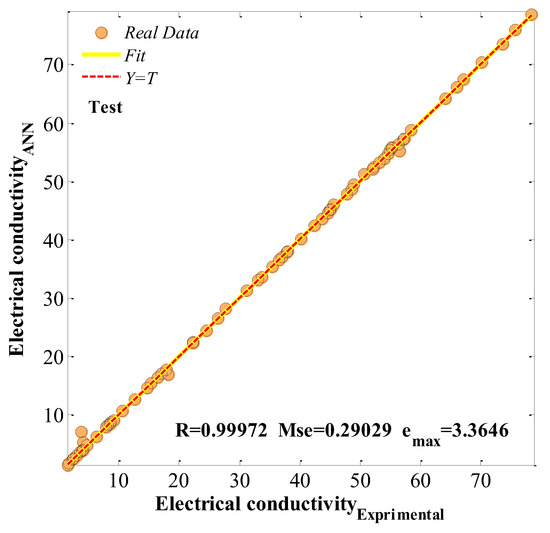
Figure 8.
Comparison of predicted values of electrical conductivity of nanofluids by neural networks and experimental results for testing data.

Figure 9.
Comparison of predicted values of electrical conductivity of nanofluids by neural networks and experimental results for all data.
In Figure 10 the data allocated to the program is shown in 3 colors: violet, green and red. Horizontal axis shows the difference between predicted values and experimental values. As can be seen, the highest and lowest error rates for the electrical conductivity were very good. The closer the data to the base line laying in the middle means a successful prediction with low error. For the training section, the violet data are closer to the base line. So it shows that the percentage of data allocated to this section has been more successful in predicting.
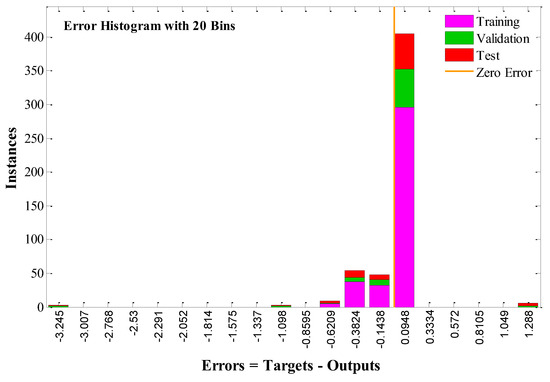
Figure 10.
Error distribution diagram for electrical conductivity of nanofluids (x-axis: difference of error value between experimental and predicted results, y-axis: number of data).
As shown in Figure 11, the training routine for the electrical conductivity data of the nanofluids is stopped if the evaluation set error occurs in 15 consecutive repetitions. This stop has occurred in repeat 11. Training data for the validation and testing section for electrical conductivity are on the normal line. But for the training section, we go away from the normal line with increasing number of repetitions. This descending value for training data is very good because the error rate is very low and very normal.

Figure 11.
Network performance diagram for the predicted electrical conductivity of the nanofluids (the number of repetitions in terms of mean squared error).
It can be said that for the ANN model, the results of the prediction of electrical conductivity of nanofluids in the work of researchers are very normal and the lowest error rate and the highest correlation coefficient can be obtained and these results are consistent with the experimental and predicted results of this study, indicating a correct evaluation with the least error.
The experimental results of the electrical conductivity of CuO/glycerol nanofluid in the two-dimensional and three-dimensional forms are shown in Figure 12 and Figure 13. As can be seen, the electrical conductivity increases as the temperature and volume fraction of the nanofluid increases. However, with an increase in the size of the nanoparticles, the electrical conductivity decreases. For example, at a temperature of 30 °C and size of 50 nm, the electrical conductivity is 30 μS/cm. However, at a temperature of 50 °C and size of 20 nm, the electrical conductivity is about 45 μS/cm, causing 33.33% increase in the electrical conductivity. With the volume concentration of 1.5% and a temperature of 50 °C, the electrical conductivity is approximately 60 μS/cm. The electrical conductivity increases with temperature, especially in higher volume fractions. These results are attributed to the accumulation of nanoparticles in the presence of the field and their Brownian motion at various temperatures. One of the reasons for the reduction of electrical conductivity at higher nanoparticle sizes is decreasing the mobility of nanoparticles as load carriers, as well as decreasing their number per volume unit for a constant volume fraction.
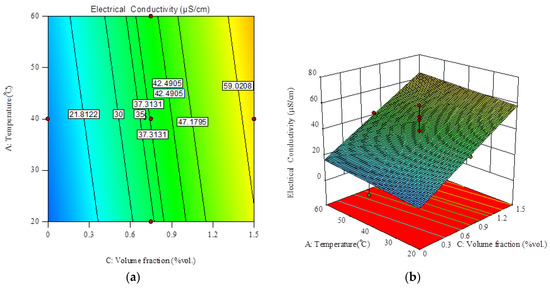
Figure 12.
Effect of temperature and volume fraction variations on the electrical conductivity of CuO/glycerol. (a) 2 dimensional; (b) 3 dimensional.
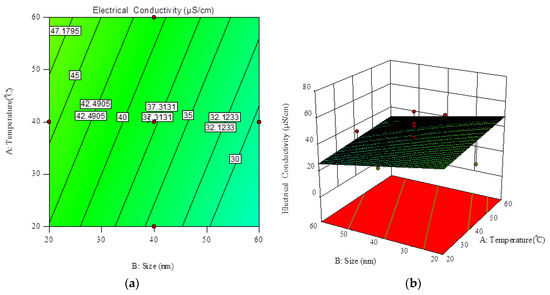
Figure 13.
Effect of temperature and nanoparticles size variations on the electrical conductivity of CuO/glycerol nanofluid. (a) 2 dimensional; (b) 3 dimensional.
Electric conductivity increases relative to temperature with an almost constant gradient. An increase in electric conductivity with temperature is associated with an increase in ionic mobility with temperature that plays a major role in the conductivity of the nanofluid. Since the nanofluid viscosity decreases with increasing temperature, the ionic mobility increases with increasing temperature and thus causes an increase in the electrical conductivity with temperature [44]. As the temperature increases, the bonds of the base fluid molecules are weakened and the structure of its mass molecules disappears, so the number of free molecules in the base fluid around the nanoparticles increases. This layer, created by the van der Waals forces of the base fluid molecules and the surface of the nanoparticles, has high electrical conductivity and therefore increases it [44]. It can also be said that since the nanoparticles used are almost spherical, then the ratio of the surface to volume increases and thus causes an increase in the electrical conductivity, too.
4. Conclusions
In the present study, electrical conductivity of CuO/Glycerol nanofluid was investigated experimentally. Then, the artificial neural network was used to predict the electrical conductivity. Volume fraction, temperature and particle size were considered as network inputs and electrical conductivity as output. The electrical conductivity increases with temperature, especially in higher volume fractions. These results are attributed to the accumulation of nanoparticles in the presence of the field and their Brownian motion at various temperatures. The obtained results showed that there is a good agreement between the predicted and experimental results and the sum of mean square error (MES) and correlation coefficient (R2) are desirable.
Author Contributions
The work is conducted and wrote by R.A. under supervision of H.M., M.H.A., W.-M.Y. and N.G.
Acknowledgments
The authors appreciate the financial support from Ministry of Science and Technology, Taiwan, under grant number MOST 106-2221-E-027-102-MY2 and MOST 106-2622-E-027-025-CC2.
Conflicts of Interest
The authors declare no conflicts of interest.
Nomenclatures
| SOM | self-organizing map |
| SEM | scanning electron microscopy |
| ANN | artificial neural network |
| MLP | multi-layer perceptron |
| BP | back propagation |
| MSE | mean square error |
References
- Xie, H.Q.; Wang, J.C.; Xi, T.G.; Liu, Y.; Ai, F.; Wu, Q.R. Thermal conductivity enhancement of suspensions containing nanosized alumina particles. J. Appl. Phys. 2002, 91, 4568–4572. [Google Scholar] [CrossRef]
- Shirvan, M.K.; Ellahi, R.; Mamourian, M.; Moghiman, M. Effect of wavy surface characteristics on heat transfer in a wavy square cavity filled with nanofluid. Int. J. Heat Mass Transf. 2017, 107, 1110–1118. [Google Scholar] [CrossRef]
- Shirvan, K.M.; Mamourian, M.; Mirzakhanlari, S.; Ellahi, R. Numerical investigation of heat exchanger effectiveness in a double pipe heat exchanger filled with nanofluid: A sensitivity analysis by response surface methodology. Power Technol. 2017, 313, 99–111. [Google Scholar] [CrossRef]
- Esfahani, J.A.; Akbarzadeh, M.; Rashidi, S.; Rosen, M.A.; Ellahi, R. Influences of wavy wall and nanoparticles on entropy generation in a plate heat exchanger. Int. J. Heat Mass Transf. 2017, 109, 1162–1171. [Google Scholar] [CrossRef]
- Hassan, M.; Zeeshan, A.; Majeed, A.; Ellahi, R. Particle shape effects on ferrofuids flow and heat transfer under influence of low oscillating magnetic field. J. Magn. Magn. Mater. 2017, 443, 36–44. [Google Scholar] [CrossRef]
- Rashidi, S.; Akar, S.; Bovand, M.; Ellahi, R. Volume of fluid model to simulate the nanofluid flow and entropy generation in a single slope solar still. Renew. Energy 2018, 115, 400–410. [Google Scholar] [CrossRef]
- Ijaz, N.; Zeeshan, A.; Bhatti, M.M.; Ellahi, R. Analytical study on liquid-solid particles interaction in the presence of heat and mass transfer through a wavy channel. J. Magn. Magn. Mater. 2018, 250, 80–87. [Google Scholar]
- Mahanthesh, B.; Gireesha, B.J.; Reddy Gorla, R.S.; Abbasi, F.M.; Shehzad, S.A. Numerical solutions for magnetohydrodynamic flow of nanofluid over a bidirectional non-linear stretching surface with prescribed surface heat flux boundary. J. Magn. Magn. Mater. 2018, 417, 189–196. [Google Scholar] [CrossRef]
- Velasco, J.; Frascella, R.; Albarracin, R.; Burgos, J.C.; Dong, M.; Yang, L. Comparison of positive streamers in liquid dielectrics with and without nanoparticles simulated with finite-element software. Energies 2018, 11, 361. [Google Scholar] [CrossRef]
- Patil, M.S.; Seo, J.H.; Kang, S.J.; Lee, M.Y. Review on Synthesis, Thermo-Physical Property, and Heat Transfer Mechanism of Nanofluids. Energies 2016, 9, 840. [Google Scholar] [CrossRef]
- Popa, C.; Nguyen, C.; Gherasim, I. New specific heat data for Al2O3 and CuO nanoparticles in suspension in water and Ethylene Glycol. Int. J. Therm. Sci. 2017, 111, 108–115. [Google Scholar] [CrossRef]
- Lopez-Munoz, G.; Pescador-Rojas, J.; Lopez, J.; Salazar, J.; Balderas-Lopez, J. Thermal diffusivity measurement of spherical gold nanofluids of different sizes/concentrations. Nanoscale Res. Lett. 2012, 7, 1–6. [Google Scholar] [CrossRef] [PubMed]
- Shoghl, S.N.; Jamali, M.; Moraveji, K.J. Electrical conductivity, viscosity, and density of different nanofluids: An experimental study. Exp. Ther. Fluid Sci. 2016, 74, 339–346. [Google Scholar] [CrossRef]
- Adio, S.A.; Sharifpur, M.; Meyer, J.P. Factors affecting the pH and electrical conductivity of MgO–ethylene glycol nanofluids. Bull. Mater. Sci. 2015, 38, 1345–1357. [Google Scholar] [CrossRef]
- Fal, J.; Sidorowicz, A.; Zyła, G. Electrical conductivity of ethylene glycol based nanofluids with different types of thulium oxide nanoparticles. Acta Phys. Pol. A 2017, 132, 146–148. [Google Scholar] [CrossRef]
- Zakaria, I.; Azmi, W.H.; Mohamed, W.A.N.W.; Mamat, R.; Najafi, G. Experimental investigation of thermal conductivity and electrical conductivity of Al2O3 nanofluid in water-ethylene glycol mixture for proton exchange membrane fuel cell application. Int. Commun. Heat Mass Transf. 2015, 61, 61–68. [Google Scholar] [CrossRef]
- Satriananda, I.N. Investigation on electrical conductivity enhancement of water based maghemite (γ-Fe2O3) nanofluids. Int. J. Mater. Sci. Appl. 2017, 6, 32–36. [Google Scholar]
- Abdolbaqi, M.K.; Azmi, W.H.; Mamat, R.; Sharma, K.V.; Najafi, G. Experimental investigation of thermal conductivity and electrical conductivity of bioglycol–water mixture based Al2O3 nanofluid. Appl. Therm. Eng. 2016, 102, 932–941. [Google Scholar] [CrossRef]
- Aguila, B.; Vasco, D.A.; Galvez’, P.; Zapata, P.A. Effect of temperature and CuO-nanoparticle concentration on the thermal conductivity and viscosity of an organic phase-change material. Int. J. Heat Mass Transf. 2018, 120, 1009–1019. [Google Scholar] [CrossRef]
- Aghayari, R.; Maddah, H.; Faramarzi, A.R.; Mohammadiun, H.; Mohammadiun, M. Comparison of the experimental and predicted data for thermal conductivity of iron oxide nanofluid using artificial neural networks. Nanomed. Res. J. 2016, 1, 15–22. [Google Scholar]
- Esfahani, M.A.; Toghraie, D. Experimental investigation for developing a new model for the thermal conductivity of silica/water-ethylene glycol (40%–60%) nanofluid at different temperatures and solid volume fractions. J. Mol. Liquids 2017, 232, 105–112. [Google Scholar] [CrossRef]
- Akbari, M.; Afrand, M.; Arshi, A.; Karimipour, A. An experimental study on rheological behavior of ethylene glycol based nanofluid: Proposing a new correlation as a function of silica concentration and temperature. J. Mol. Liquids 2017, 233, 352–357. [Google Scholar] [CrossRef]
- Nadooshan, A.A. An experimental correlation approach for predicting thermal conductivity of water-EG based nanofluids of zinc oxide. Phys. E Low-Dimens. Syst. Nanostruct. 2017, 87, 15–19. [Google Scholar] [CrossRef]
- Hemmat Esfe, M.; Razi, P.; Hajmohammad, M.H.; Rostamian, S.H.; Sarsam, W.S.; Abbasian Arani, A.A.; Dahari, M. Optimization, modeling and accurate prediction of thermal conductivity and dynamic viscosity of stabilized ethylene glycol and water mixture Al2O3 nanofluids by NSGA-II using ANN. Int. Commun. Heat Mass Transf. 2017, 82, 154–160. [Google Scholar] [CrossRef]
- Moghaddam, M.A.; Motahari, K. Experimental investigation, sensitivity analysis and modeling of rheological behavior of MWCNT-CuO (30–70)/SAE40 hybrid nano-lubricant. Appl. Therm. Eng. 2017, 123, 1419–1433. [Google Scholar] [CrossRef]
- Hemmat Esfe, M.; Hassani Ahangar, M.R.; Rejvani, M.; Toghraie, D.; Hajmohammad, M.H. Designing an artificial neural network to predict dynamic viscosity of aqueous nanofluid of TiO2 using experimental data. Int. Commun. Heat Mass Transf. 2016, 75, 192–196. [Google Scholar] [CrossRef]
- Vakili, M.; Karami, M.; Delfani, S.H.; Khosrojerdi, S.; Kalhor, K. Experimental investigation and modeling of thermal conductivity of CuO–water/EG nanofluid by FFBP-ANN and multiple regressions. J. Therm. Anal. Calorim. 2017, 129, 629–637. [Google Scholar] [CrossRef]
- Maddah, H.; Ghasemi, N. Experimental evaluation of heat transfer efficiency of nanofluid in a double pipe heat exchanger and prediction of experimental results using artificial neural networks. Heat Mass Transf. 2017, 53, 3459–3472. [Google Scholar] [CrossRef]
- Yaïci, W.; Longo, M.; Entchev, E.; Foiadelli, F. Simulation study on the effect of reduced inputs of artificial neural networks on the predictive performance of the solar energy system. Sustainability 2017, 9, 1382. [Google Scholar] [CrossRef]
- Ahmed, M.S.; Mohamend, A.; Homod, R.Z.; Shareef, H. Hybrid LSA-ANN based home energy management scheduling controller for residential demand response strategy. Energies 2016, 9, 716. [Google Scholar] [CrossRef]
- Lu, J.; Lu, F.; Huang, J. Performance estimation and fault diagnosis based on Levenberg–Marquardt algorithm for a turbofan rngine. Energies 2018, 11, 181. [Google Scholar]
- Hadadian, M.; Goharshadi, E.K.; Youssefi, A. Electrical conductivity, thermal conductivity, and rheological properties of graphene oxide-basednanofluids. J. Nanopart Res. 2014, 16, 2788. [Google Scholar] [CrossRef]
- Glover, B.; Whites, K.W.; Hong, H.; Mukherjee, A.; Billups, W.E. Effective electrical conductivity of functional single-wall carbon nanotubes in aqueous fluids. Synth. Met. 2008, 158, 506–508. [Google Scholar] [CrossRef]
- Dong, M.; Shen, L.P.; Wang, H.; Wang, H.B.; Miao, J. Investigation on the electrical conductivity of transformer oil-based AlN nanofluid. J. Nanomater. 2013, 2013, 842963. [Google Scholar] [CrossRef]
- White, S.; Shih, A.; Pipe, K.P. Investigation of the electrical conductivity ofpropylene glycol-based ZnO nanofluids. Nanoscale Res. Lett. 2011, 6, 346–351. [Google Scholar] [CrossRef] [PubMed]
- Kalpana Sarojini, K.G.; Manoj, S.V.; Singh, P.K.; Pradeep, T.; Das, S.K. Electrical conductivity of ceramic and metallic nanofluids. Colloids Surfaces A Physicochem. Eng. Asp. 2013, 417, 39–46. [Google Scholar] [CrossRef]
- Azimi, H.R.; Taheri, R. Electrical conductivity of CuO nanofluids. Int. J. Nano Dimens. 2015, 6, 77–81. [Google Scholar]
- Kole, M.; Dey, T.K. Investigation of thermal conductivity, viscosity, and electrical conductivity of graphene based nanofluids. J. Appl. Phys. 2013, 113, 084307. [Google Scholar] [CrossRef]
- Ganguly, S.; Sikdar, S.; Basu, S. Experimental investigation of the effective electrical conductivity of aluminumoxide nanofluids. Powder Technol. 2009, 196, 326–330. [Google Scholar] [CrossRef]
- Goharshadi, K.; Azizi-Toupkanloo, H. Silver colloid nanoparticles: Ultrasound-assisted synthesis, electrical and rheological properties. Powder Technol. 2013, 237, 97–101. [Google Scholar] [CrossRef]
- Konakanchi, H.; Vajjha, R.; Misra, D.; Das, D. Electrical conductivity measurements of nanofluids and development of new correlations. J. Nanosci. Nanotechnol. 2011, 11, 6788–6795. [Google Scholar] [CrossRef] [PubMed]
- Zawrah, M.F.; Khatta, R.M.; Girgis, L.G.; Daidamony, H.E.; Abdel Aziz, R.E. Stability and electrical conductivity of water-base Al2O3 nanofluids for different applications. HBRC J. 2016, 12, 227–234. [Google Scholar] [CrossRef]
- Bagheli, S.; Fadafan, H.K.; Orimi, R.L.; Ghaemi, M. Synthesis and experimental investigation of the electrical conductivity of water based magnetite nanofluids. Powder Technol. 2015, 274, 426–430. [Google Scholar] [CrossRef]
- Kang, Z.; Wang, L. Effect of thermal-electric cross coupling on heat transport in nanofluids. Energies 2017, 10, 123. [Google Scholar] [CrossRef]
© 2018 by the authors. Licensee MDPI, Basel, Switzerland. This article is an open access article distributed under the terms and conditions of the Creative Commons Attribution (CC BY) license (http://creativecommons.org/licenses/by/4.0/).